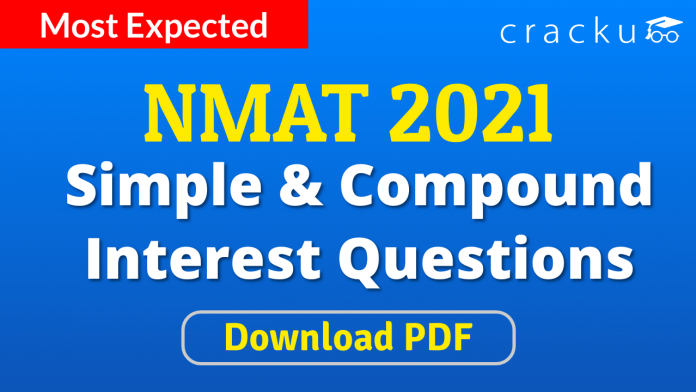Simple and Compound Interest Questions for NMAT:
Download Simple and Compound Interest Questions for NMAT PDF. Top 10 very important Simple and Compound Interest Questions for NMAT based on asked questions in previous exam papers.
Download Simple and Compound Interest Questions for NMAT
Take NMAT mock test
Question 1: A sum of money compounded annually becomes Rs.625 in two years and Rs.675 in three years. The rate of interest per annum is
a) 7%
b) 8%
c) 6%
d) 5%
Question 2: Ms. Debjani after her MBA graduation wants to have start-up of her own. For this, she uses ₹ 8,00,000 of her own savings and borrows ₹ 12,00,000 from a public sector bank under MUDRA Scheme.As per the agreement with the bank,she is supposed to repay the principle of this loan equally over the period of the loan which is 25 years. Two years after taking the first loan, she borrowed an additional loan of ₹ 8,00,000 to finance expansion plan of her start-up. If Ms Debjani clears all her loans in 25 years from the date of taking the first loan, how much total interest she has to pay on her initial borrowing? Assume simple interest rate at 8 per cent per annum.
a) Rs.12,48,000
b) Rs.12,84,000
c) Rs.14,20,000
d) Rs.12,96,000
Question 3: In the beginning of the year 2004, a person invests some amount in a bank. In the beginning of 2007, the accumulated interest is Rs. 10,000 and in the beginning of 2010, the accumulated interest becomes Rs. 25,000. The interest rate is compounded annually and the annual interest rate is fixed. The principal amount is:
a) Rs. 16,000
b) Rs. 18,000
c) Rs. 20,000
d) Rs. 25,000
e) None of the above
Question 4: Amal invests Rs 12000 at 8% interest, compounded annually, and Rs 10000 at 6% interest, compounded semi-annually, both investments being for one year. Bimal invests his money at 7.5% simple interest for one year. If Amal and Bimal get the same amount of interest, then the amount, in Rupees, invested by Bimal is
Question 5: To start a new enterprise, Mr. Yogesh has borrowed a total of Rs. 60,000 from two money lenders with the interest being compounded annually, to be repaid at the end of two years. Mr. Yogesh repaid Rs.38, 800 more to the first money lender compared to the second money lender at the end of two years. The first money lender charged an interest rate, which was 10% more than what was charged by the second money lender. If Mr. Yogesh had instead borrowed Rs. 30,000 from each at their respective initial rates for two years, he would have paid Rs.7, 500 more to the first money lender compared to the second. Then money borrowed by Mr. Yogesh from first money lender is?
a) 20,000
b) 35,000
c) 40,000
d) 42,000
Question 6: The simple interest accrued on a sum of certain principal in 8 years at the rate of 13% per year is Rs.6500. What would be the compound interest accrued on that principal at the rate of 8% per year in 2 years?
a) Rs.1040
b) Rs.1020
c) Rs.1060
d) Rs.1200
Question 7: Mr. Mishra invested Rs.25,000 in two fixed deposits X and Y offering compound interest @ 6% per annum and 8% per annum respectively. If the total amount of interest accrued in two years through both fixed deposits is Rs.3518, the amount invested in Scheme X is
a) Rs. 12,000
b) Rs. 13,500
c) Rs. 15,000
d) Cannot be determined
Question 8: Mr. Mehra is planning for higher education expenses of his two sons aged 15 and 12. He plans to divide Rs 15 lakhs in two equal parts and invest in two different plans such that his sons may have access to Rs 21 lakhs each when they reach the age of 21. He is looking for plans that will give him a simple interest per annum. The rates of interest of the plans for his younger son and his elder son should be
a) 5% and 7.5% respectively
b) 8% and 12% respectively
c) 10% and 15% respectively
d) 15 % and 22.5% respectively
e) 20% and 30% respectively
Question 9: Three years ago, your close friend had won a lottery of Rs. 1 crore. He purchased a flat for Rs. 40 lakhs, a car for Rs. 20 lakhs and shares worth Rs. 10 lakhs. He put the remaining money in a bank deposit that pays compound interest @ 12 percent per annum. If today, he sells off the flat, the car and the shares at certain percentage of their original value and withdraws his entire money from the bank, the total gain in his assets is 5%. The closest approximate percentage of the original value at which he sold off the three items is
a) 60 percent
b) 75 percent
c) 90 percent
d) 105 percent
Question 10: Swarn a SME enterprise borrowed a sum of money from a nationalized bank at 10% simple interest per annum and the same amount at 8% simple interest per annum from a microfinance firm for the same period: It cleared the first loan 6 months before the scheduled date of repayment and repaid the second loan just at the end of the scheduled period: If in each case it had to pay Rs. 62100 as amount then how much money and for what time period did it borrow?
a) Rs. 55750, 2 years
b) Rs. 52500, 2 years
c) Rs. 51750, 2.5 years
d) Rs. 55750, 2.5 years
Join 7K MBA Aspirants Telegram Group
Download Highly Rated CAT preparation App
Answers & Solutions:
1) Answer (B)
As we know, formulae of compound interest for 2 years will be:
$P(1+\frac{r}{100})^{2}$ = 625 (Where r is rate, P is principal amount)
For 3 years:
$P(1+\frac{r}{100})^{3}$ = 675
Dividing above two equations we will get r=8%
2) Answer (A)
For the first year, interest= 1200000*0.08
It has been given that she repays the principal of the loan in 25 years i.e she pays $\frac{1200000}{25}$ = Rs 48000 at the end of every year.
Therefore the interest for the second year is calculated only on the remaining sum i.e 1200000-48000 = Rs 1152000
for the second year, interest = 1152000*0.08
On similar lines for the twenty-fifth year = 48000*0.08
This is in AP with first term 48000*0.08 with common difference 3840
Total interest = $\ \frac{\ 25}{2}\left(2\times\ 48000\cdot0.08+24\cdot3840\right)$
=1248000
A is the correct answer.
3) Answer (C)
Let the principal amount = $P$ and rate of interest = $r \%$
Interest accumulated from 2004 to 2007 is Rs.10,000 and from 2004 to 2010 is Rs.25,000
Using, $C.I. = P[(1 + \frac{R}{100})^T – 1]$
=> $P[(1 + \frac{r}{100})^3 – 1] = 10,000$ ———-Eqn(I)
and $P[(1 + \frac{r}{100})^6 – 1] = 25,000$ ———–Eqn(II)
Dividing eqn(II) from (I), we get :
=> $\frac{P[(1 + \frac{r}{100})^6 – 1]}{P[(1 + \frac{r}{100})^3 – 1]} = \frac{5}{2}$
Let $(1 + \frac{r}{100})^3 = x$
=> $\frac{x^2 – 1}{x – 1} = \frac{5}{2}$
=> $2x^2 – 5x + 3 = 0$
=> $(2x – 3) (x – 1) = 0$
=> $x = \frac{3}{2} , 1$ $(x \neq 1)$ because then, r = 0
=> $(1 + \frac{r}{100})^3 = \frac{3}{2}$
Substituting it in eqn(I)
=> $P[\frac{3}{2} – 1] = 10,000$
=> $P = 10,000 \times 2 = 20,000$
4) Answer: 20920
The amount with Amal at the end of 1 year = 12000*1.08+10000*1.03*1.03=23569
Interest received by Amal = 23569-22000=1569
Let the amount invested by Bimal = 100b
Interest received by Bimal = 100b*7.5*1/100=7.5b
It is given that the amount of interest received by both of them is the same
7.5b=1569
b=209.2
Amount invested by Bimal = 100b = 20920
5) Answer (C)
Let the interest on the second part be $r$ %
Then, the rate on the first part = ($r$ + 10)%It is given that,
$30000(1 + \dfrac{r + 10}{100})^2 – 30000(1 + \dfrac{r}{100})^2 = 7500$
On solving, we get $r$ = 20%
Let the first part be Rs. $a$
Then, the second part = Rs. (60000 – $a$)
$a(1 + \dfrac{20 + 10}{100})^2 – (60000 – a)(1 + \dfrac{20}{100})^2$ = 38800
On solving, we get $a$ = Rs. 40000
Hence, option C is the correct answer.
6) Answer (A)
Simple Interest = $\ \frac{\ P\cdot T\cdot r}{100}$ where P is the principal, T is the time period and r is the rate of interest.
The simple interest accrued on a sum of certain principal in 8 years at the rate of 13% per year is Rs.6500
6500=$\ \frac{\ P\times\ 8\times\ 13}{100}$
P = Rs. 6250
Compound Interest on 6250 for 2 years at 8% rate of interest = 6250$\left(1+\ \frac{\ 8}{100}\right)^2$- 6250
= Rs. 1040
A is the correct answer.
7) Answer (C)
Let the amount invested in X = x
Thus, the amount invested in Y = 25000-x
The interest incurred = 3518 Rs, thus the total amount at the end of the 2nd year = 28518 Rs.
Thus, $x*(1.06)^2 + (25000-x)*(1.08)^2 = 28518$
=> $x*1.1236 + 25000*1.11664 – x*1.11664 = 28518$
=> $-0.0428x + 29160 = 28518$
=> $ 642 = 0.0428x$
Hence, $x = 15000 Rs$
Hence, option C is the correct answer.
8) Answer (E)
Rs. 15 lakhs is to be divided equally.
In the case of the younger son,
Principal = Rs. 750000, time = 9 years and Interest = Rs. 1350000
Rate of interest = $\dfrac{1350000 * 100}{750000 * 9}$ = 20%
In the case of the elder son,
Principal = Rs. 750000, time = 6 years and Interest = Rs. 1350000
Rate of interest = $\dfrac{1350000 * 100}{750000 * 6}$ = 30%
Hence, option E is the correct answer.
9) Answer (C)
Hi total gain = 5%
Thus, the amount at the end of 3 years = 105 lakh Rupees
The amount he gets from the bank = $30(1.12)^3 = 42.14784$ lakh rupees
Let x be the percentage at which he sells the assets of worth 70 lakhs
Thus, the amount he gets = 0.7x lakhs
Thus, 70x + 42.1478 = 105
Thus, 70x = 62.8525
Thus, x is closest to 0.90= 90%
Hence, option C is the correct answer.
10) Answer (C)
The sum that was returned is same in both cases that means interest accrued is same in both cases.
Assume that the duration is ‘t’ years for which amount is borrowed in both case and principal amount is ‘P’.
$\frac{P*(t-0.5)*10} {100}$ = $\frac{P*t*8} {100}$
t=2.5 years
Principal amount that the enterprise borrowed :
$P(1+\frac{2*10}{100})$ =62100
P=51750
We hope this Simple and Compound Interest Questions for NMAT pdf for NMAT exam will be highly useful for your Preparation.






